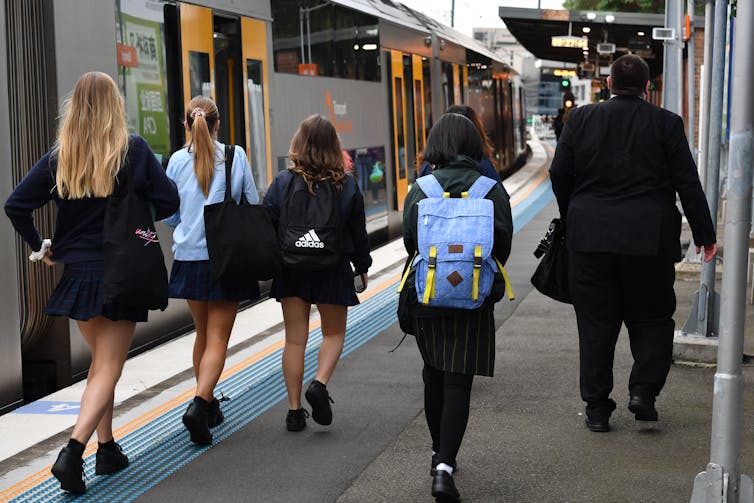While schools and school-related contexts were often sites of harm for our participants, schools nonetheless have a vitally important role to play here. Harassment in school uniform should not be seen as a “normal” part of growing up, writes Bianca Fileborn and Jess Hardley from The University of Melbourne in this article republished from The Conversation.
Can you remember the first time you were harassed in a public space? What comes to mind? Can you remember how old you were, or what you were doing? Perhaps this is not something you have personally experienced, although we know 87% of young Australian women have been harassed in public.
We spoke to 47 adult women and LGBTQ+ people in our recent study on street-based and public harassment about their earliest memories of feeling sexualised, uncomfortable or unsafe on the street. Many mentioned they first experienced street harassment in their school uniforms. We heard variations of the phrase “it happened when I was in my school uniform” repeatedly from participants.
For many, street harassment began or became more frequent when they started wearing a high school uniform. Some participants, however, reflected on experiences from when they were even younger, wearing a primary school uniform.
Studies from the United Kingdom have shown 35% of girls wearing school uniforms have been sexually harassed in public spaces. Despite the importance of schools in the daily lives of young people, and the high rates of street harassment they experience, there’s been surprisingly little attention paid to the harassment of young people in school uniform.
Findings from our new research show school-related harassment is a serious issue that has largely flown under the radar in Australia.
It happens beyond the school gates
We know young people experience sexual, homophobic and transphobic harassment from their peers and even teachers while they’re at school.
But participants also told us about harassment occurring outside their school grounds. This was perpetrated by strangers (usually individual adult men, or groups of adult men), while they were in uniform and, therefore, clearly identifiable as school children.
This took many forms, ranging from catcalling, staring or leering, wolf-whistling, and being followed by men in cars while walking to school, through to public masturbation and men rubbing themselves against victim-survivors (usually while travelling to school on public transport), sexual assault and rape. As one interviewee told us:
walking from high school to home […] that’s where most of the harassment I’ve experienced happened […] As soon as I stopped wearing a school uniform it happened less. So that’s disgusting for a lot of reasons.
As another interviewee shared, these experiences were really scary not just because of what was happening at that moment but because the perpetrator “knows which school you go to” because of the uniform worn.

The ‘sexy schoolgirl’
Why is it that young people – and particularly young women and girls – are so routinely harassed in school uniform? We found harassment of schoolgirls was seen as being culturally sanctioned through the “sexy schoolgirl” trope. As one interviewee noted:
when you go on Google images and search for ‘school boy’ it will come up with a five-year-old boy but then ‘school girl’ it will come up with the sexy school girl costume.
Participants discussed being targeted because they were viewed as vulnerable and (paradoxically) as both sexually innocent and sexualised:
that was part of the allure for them [the perpetrators], the innocence of a schoolgirl, a fearful schoolgirl in that situation, was like hot to them, they were really getting off on it.
Another interviewee told us:
I went from being an innocent child to a child that felt uncomfortable and didn’t know why I was sexualised – and I didn’t understand it because I didn’t understand what sex really was.
Because they were so young, many participants often lacked a framework or language to understand their experiences. For many, these experiences were also so routine they simply formed part of the background hum of everyday life.
It was often not until years after these formative experiences that participants were able to articulate them as sexual harm and reflect on the impacts.
Trying to avoid harassment
Across our interviews, many participants discussed changing the way they presented themselves or changing the routes they took to school. They often focused on changing their own behaviour and made their lives smaller in an attempt to avoid further harassment. For example:
I started walking the long way. I started just going through the main roads, avoiding the back streets, even though it was a longer walk to be extra safe.
In the longer-term, participants commonly described feeling unsafe, hyper-vigilant, and distrustful of men in public spaces.
‘What if there’s a paedophile on the tram?’: school responses
Unfortunately, the view that victim-survivors are responsible for their own harassment was often reinforced by schools if harassment was reported.
Numerous participants told us how they were reminded of school uniform policies (such as mandated length of skirts and dresses) when they went to teachers for help. One participant recounted an experience where her teacher asked:
Why would you wear your skirt like this [short]? Whose attention are you trying to get? […] what if there’s a paedophile when you’re on the tram home from school […] thinking ‘this is the best day of [my] life’.
Others did not seek help from their teachers because of this focus on students’ appearance at school – they felt they would simply be blamed for what happened.
These types of responses teach young people to think street harassment and other forms of gendered violence are their fault. It also tells them their bodies are sites of risk that need to be managed and contained to avoid harassment.
School uniform harassment is not ‘normal’
While schools and school-related contexts were often sites of harm for our participants, schools nonetheless have a vitally important role to play here. Harassment in school uniform should not be seen as a “normal” part of growing up.
There is an urgent need to provide young people with a framework to understand their experiences.

Educational efforts must challenge the idea that harassment must simply be endured. Instead, schools should help young people understand harassment as a form of violence, and offer safe and supportive spaces to talk with peers and adults about their experiences. This should be incorporated into existing sex and relationships education in an age-appropriate way.
Importantly, responses to harassment should never blame or implicate young people themselves. It’s time for outdated practices such as measuring school uniform length to be relegated to the past where they belong.
In the words of one participant, “the length of my skirt is not influencing how much I learn”.


